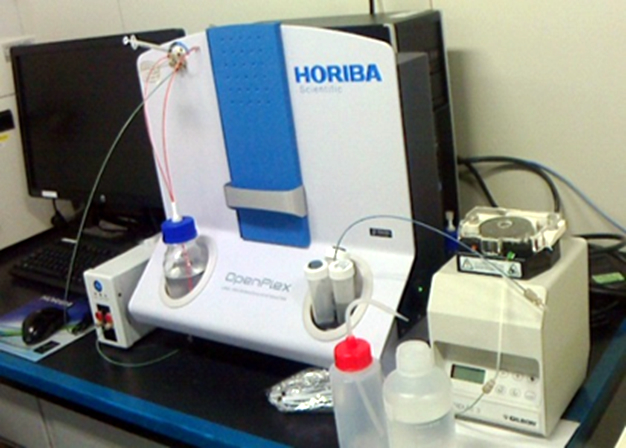
ここからコンテンツです。

Simple operation for detecting residual pesticides in agricultural products anytime anywhere
By Seiji Iwasa
Prof. Iwasa’s research group (S. Iwasa, Toyohashi University of Technology; S. Miyake, Advanced Scientific Technology & Management Research Institute of Kyoto, Research & Development Division, Horiba, Ltd.; T. Ohtake, Aichi Agricultural Research Center; K. Adachi and S. Saito, Aichi Science & Technology Foundation) has established immuochromatography kits and an immunosensor based on surface plasmon resonance (SPR-sensor) for the detection of residual pesticides in agricultural products. Immuochromatography kits were found to be a rapid, highly sensitive and low cost method for residual pesticide determination. SPR-sensors could detect more than 6 different types of pesticide at the same time. The working sensitivity of these methods was up to the level of 10ng/mL. These methods can be applied to the safety control of agricultural products.
Pesticides play an important role in increasing the productivity of agricultural products. At the same time, the detection and safety control of the residual pesticides is also necessary because of their toxicity. The residual pesticide in agricultural products has been mainly measured by instrumental analysis such as GC-MS and LC-MS so far.
The procedure of using instruments to perform an accurate detection analysis of residual pesticides in agricultural products is well established. This kind of instrumental analysis is, however, expensive, time consuming, and requires specific training. Thus, it would obviously be beneficial to be able to detect residual pesticides with simple, low cost operation, allowing rapid analysis without any special skill.
In this regard, we have established immuochromatography kits and an immunosensor based on surface plasmon resonance (SPR-sensor) for the detection of residual pesticides in agricultural products. When an antibody of the target pesticide is applied to the immunosensor, hapten synthesis is required because of the small size of the target molecule. This is one of the most important steps for preparing a highly sensitive monoclonal antibody for target molecule. We have synthesized more than 20 pesticide haptens and their antibodies at Toyohashi University of Technology and the Advanced Scientific Technology & Management Research Institute of Kyoto and Research & Development Division, Horiba, Ltd. The resulting monoclonal antibody was successfully set up as an immuochromatography kit. The kit visually displays the target pesticide by colorizing and also immediately determines the concentration of the residual pesticide. All it requires is to take a photo using a standard mobile phone camera. (Fig. 2)

Immuochromatography kits were found to be a rapid, highly target selective and low cost method for residual pesticide detection. This tool can be utilized anytime, anywhere, for self-managing the safety control of foods such as agricultural products. We believe that the cost performance and easy operation combined with high accuracy are great advantages compared to the standard instrument analysis. Furthermore, SPR-sensors can detect up to 6 different types of pesticide at the same time. The working sensitivity of these methods is up to 10ng/mL.These can be also applied to the safety control of agricultural products, especially in large-scale production areas. (Fig. 3)

See more at
- http://www.siorgchem.ens.tut.ac.jp/research/index.html
- http://www.siorgchem.ens.tut.ac.jp/work/index.html
- http://www.tut.ac.jp/english/newsletter/contents/2016/06/features/features.html#sthash.3OHg0Msq.dpuf
Patents
- 特願2015-017356 「抗ボスカリド抗体および該抗体を用いたボスカリド測定方法」
- 特願2015-110192 「イムノアッセイ法を用いた茶の残留農薬検査のための前処理法、および残留農薬検査法」
- 特願2015-110192 「茶の残留農薬検査のための前処理法」
- 特願2015-204622 「機器分析による残留農薬検査のための前処理法」
Reference
Hirakawa, Y., Yamasaki, T.; Watanabe, E.; Okazaki, F.; Murakami-Y., Y.; Oda, M.; Iwasa, S.; Narita, H.; Miyake, S., "Development of an Immunosensor for Determination of the Fungicide Chlorothalonil in Vegetables, using Surface Plasmon Resonance" Journal of Agricultural and Food Chemistry, 63, 28, [6325−6330], (2015). DOI:10.1021/acs.jafc.5b01980.
Hirakawa, Y.; Yamasaki, T.; Harada, A.; Ohtake, T.; Adachi, K.; Iwasa, S.; Narita, H.; Miyake, S. "Analysis of the Fungicide Boscalid in Horticultural Crops Using an Enzyme-Linked Immunosorbent Assay and an Immunosensor Based on Surface Plasmon Resonance" Journal of Agricultural and Food Chemistry, 63, 28, [6325−6330], (2015). DOI:10.1021/acs.jafc.5b01980.
Y. Nakagawa, S. Chanthamath, K. Shibatomi, S. Iwasa, “Ru(II)-Pheox Catalyzed Asymmetric Intermolecular Cyclopropanation of Electron-Deficient Olefins”, Organic Letters, 17, [2792−2795], (2015). DOI:10.1021/acs.orglett.5b01201.
山崎 朋美, 井上 知美, 平川 由紀, 三宅 司郎, 上野 英二, 斎藤 勲「ELISAキットによる野菜・果実中残留農薬分析の妥当性評価の試み」食品衛生学雑誌, 56: 240-246 (2015).
だれでもどこでも早く安く検査できる残留農薬検査法
農産物の安全管理のために、生物の免疫システムである抗体反応を活用して簡便に調べることのできるイムノクロマト法による残留農薬検査(Immunochromatography Kit)およびさらに表面プロズモン共鳴(Surface Plasmon Resonance: SPR)を利用した残留農薬の多標的同時検査システムの開発に成功しました。従来の、検査機器は大型で高価なうえ、熟練した専門家が必要で検査に時間を要するものが多いのですが、ここでは生産現場や海外などで簡便に素早く使える安価なシステムを確立し、感度は10ng/mLレベルに達しました。
農薬は野菜や果物などの安定供給のために重要であると同時に、残留農薬の管理は食の安全確保のために不可欠です。現在、残留農薬検査は、GC-MS、LC-MSなどの分析機器を用いた方法が主流となっています。この分析機器を用いた検査は高精度の分析が可能であるという利点がある反面、高価、要日数等の課題が残されています。このため、農産物の出荷前に、より多くの検体を検査するためには、簡便・迅速・安価な方法が必要となります。そこで、本研究では抗原抗体反応を利用した免疫測定法(イムノアッセイ)法を利用し、廉価で迅速かつ正確に測定できる農薬検出技術を確立することを狙いとし、測定の簡便性に重点をおき、イムノクロマト法を用いた残留農薬簡易検査キットを開発しました。
抗原抗体反応を利用する場合、農薬のような低分子物質は免疫応答を起こしにくいため、標的農薬にリンカーを導入しハプテンを合成し、これと高分子タンパクと結合させマウス免疫により標的農薬抗体を作製します。その後、モノクロナール抗体として単離・精製し、キット化します。また多標的残留農薬の同時検出のためにSPR-sensorの開発にも成功しました。これらのプロセス開発によって廉価、高感度、迅速な測定時間で多様な測定状況に対応する世界で初めての残留農薬キットが完成しました。
免疫測定法(イムノアッセイ)は原理的に抗原抗体反応を利用するため、微量で標的物質を特異的に認識します。特に本技術では以下のような優位性があります。1)相対的に超低分子の標的農薬の特定や定量ができる。2)廉価、3)迅速な分析時間、4)多様な測定環境に対応、5)簡便な前処理、6)少量の使用有機溶媒等、既存の総合的機器分析システムに比べて大きな利点と技術的優位性があります。
開発した技術には、特に、廉価、迅速な分析時間、多様な測定環境に対応、簡便な前処理等の特徴があります。これらの利点を活かして農薬を使用する野菜や果物などに関わる生産者、集荷場、食品加工業者、農薬生産販売企業、輸出入業者および消費者などの広範な局面で直接的かつ重層的に活用され食の安心、安全に寄与することが期待されます。
Funding Agencies
1) Aichi Science & Technology Foundation Aichi Science & Technology Foundation, 2) Aichi Agricultural Research Center, 3) Toyohashi University of Technology, 4) Aichi Prefectural Institute of Public Health, 5) Advanced Scientific Technology & Management Research Institute of KYOTO
Researcher Profile

| Name | Seiji Iwasa |
|---|---|
| Affiliation | Department of Environmental and Life Science |
| Title | Professor |
| Fields of Research | Organic Chemistry / Organometallics |
ここでコンテンツ終わりです。
